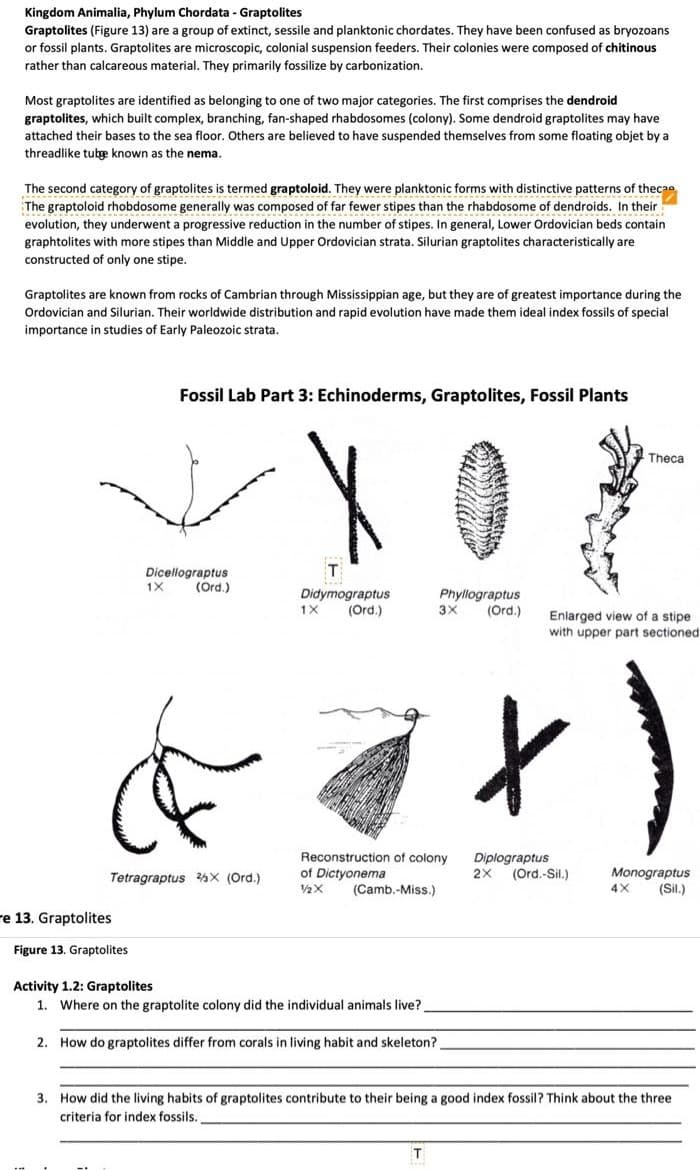1. Where on the graptolite colony did the individual animals live? 2. How do graptolites differ from corals in living habit and skeleton? 3. How did the living habits of graptolites contribute to their being a good index fossil? Think about the three criteria for index fossils.
1. Where on the graptolite colony did the individual animals live? 2. How do graptolites differ from corals in living habit and skeleton? 3. How did the living habits of graptolites contribute to their being a good index fossil? Think about the three criteria for index fossils.
Concepts of Biology
1st Edition
ISBN:9781938168116
Author:Samantha Fowler, Rebecca Roush, James Wise
Publisher:Samantha Fowler, Rebecca Roush, James Wise
Chapter15: Diversity Of Animals
Section: Chapter Questions
Problem 1ACQ: Figure 15.3 Which of the following statements is false? a. Eumetazoa have specialized tissues and...
Related questions
Question
Please solve very soon completely

Transcribed Image Text:Kingdom Animalia, Phylum Chordata - Graptolites
Graptolites (Figure 13) are a group of extinct, sessile and planktonic chordates. They have been confused as bryozoans
or fossil plants. Graptolites are microscopic, colonial suspension feeders. Their colonies were composed of chitinous
rather than calcareous material. They primarily fossilize by carbonization.
Most graptolites are identified as belonging to one of two major categories. The first comprises the dendroid
graptolites, which built complex, branching, fan-shaped rhabdosomes (colony). Some dendroid graptolites may have
attached their bases to the sea floor. Others are believed to have suspended themselves from some floating objet by a
threadlike tute known as the nema.
The second category of graptolites is termed graptoloid. They were planktonic forms with distinctive patterns of thecae
The graptoloid rhobdosome generally was composed of far fewer stipes than the rhabdosome of dendroids. In their
evolution, they underwent a progressive reduction in the number of stipes. In general, Lower Ordovician beds contain
graphtolites with more stipes than Middle and Upper Ordovician strata. Silurian graptolites characteristically are
constructed of only one stipe.
Graptolites are known from rocks of Cambrian through Mississippian age, but they are of greatest importance during the
Ordovician and Silurian. Their worldwide distribution and rapid evolution have made them ideal index fossils of special
importance in studies of Early Paleozoic strata.
Fossil Lab Part 3: Echinoderms, Graptolites, Fossil Plants
Theca
T
Dicellograptus
1X
(Ord.)
Didymograptus
(Ord.)
Phyllograptus
(Ord.)
1X
Enlarged view of a stipe
with upper part sectioned
Reconstruction of colony
of Dictyo
Diplograptus
rd.-Si
Monograptus
(Sil.)
Tetragraptus %X (Ord.)
(Camb.-Miss.)
re 13. Graptolites
Figure 13. Graptolites
Activity 1.2: Graptolites
1. Where on the graptolite colony did the individual animals live?
2. How do graptolites differ from corals in living habit and skeleton?
3. How did the living habits of graptolites contribute to their being a good index fossil? Think about the three
criteria for index fossils.
Expert Solution
This question has been solved!
Explore an expertly crafted, step-by-step solution for a thorough understanding of key concepts.
This is a popular solution!
Trending now
This is a popular solution!
Step by step
Solved in 2 steps

Knowledge Booster
Learn more about
Need a deep-dive on the concept behind this application? Look no further. Learn more about this topic, biology and related others by exploring similar questions and additional content below.Recommended textbooks for you

Concepts of Biology
Biology
ISBN:
9781938168116
Author:
Samantha Fowler, Rebecca Roush, James Wise
Publisher:
OpenStax College


Biology Today and Tomorrow without Physiology (Mi…
Biology
ISBN:
9781305117396
Author:
Cecie Starr, Christine Evers, Lisa Starr
Publisher:
Cengage Learning

Concepts of Biology
Biology
ISBN:
9781938168116
Author:
Samantha Fowler, Rebecca Roush, James Wise
Publisher:
OpenStax College


Biology Today and Tomorrow without Physiology (Mi…
Biology
ISBN:
9781305117396
Author:
Cecie Starr, Christine Evers, Lisa Starr
Publisher:
Cengage Learning